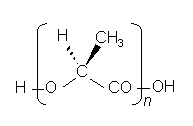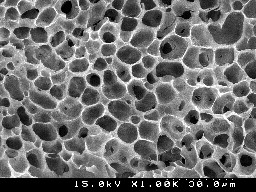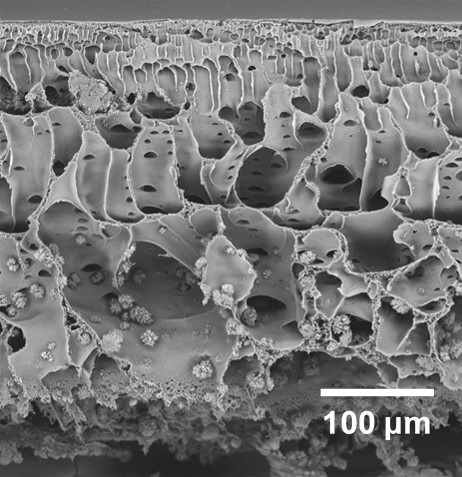To Japanese page
Laboratory of Biofunctional Materials
Dr. T. Tanaka's Research Group, Dept. of Materials Sci. & Tech., Niigata Univ.
3rd Floor, Niigata University Reseach Institute for Science of Matter and Industrial Science
Phone: +81-(0)25-262-7495; e-mail: 
Focus: Development of Biofunctional Materials
We are developing high-performance biofunctional materials and their applications.
The studies are related to Biochemical Engineering ( -> Go) , Biomaterials Engineering ( -> Go) , and Biocatalytic Engineering ( -> Go) .
Our research is supported by many collaborators, grants, and samples from industries.
Biochemial Engineering
Dr. Tanaka's Research Group studies bioproduction of bioactive compounds and bioseparation in food and biochemical industries with Prof. Emeritus M. Taniguchi of Niigata University and Prof. Emeritus K. Nakanishi of Okayama Univerisity.
Publications on Biochemical Engineering
T. Tanaka, Y. Yamagiwa, T. Nagano, M. Taniguchi, K. Nakanishi, Relationship between cake structure and membrane pore size in crossflow filtration of microbial cell suspension containing fine particles, J. Chem. Eng. Jpn., 34, 1524-1531 (2001).
T. Kouya, K. Tobita, M. Horiuchi, E. Nakayama, H. Deguchi, T. Tanaka, M. Taniguchi, Production of extracellular bifidogenic growth stimulator (BGS) from Propionibacterium shermanii using a bioreactor system with a microfiltration module and an on-line controller for lactic acid concentration, J. Biosci. Bioeng., 105, 184-191 (2008).
Y. Ishiyama, T. Takata, T. Nakanishi, N. Watanabe, M. Kaneoke, K. Watanabe, T. Tanaka, M. Taniguchi, Production of bacteriocin by Staphylococcus sp. NPSI 38 in koji extract medium with rice protein hydrolyzate and its growth-inhibitory activity against hiochi-bacteria, Food Sci. Technol. Res., 14, 239-248 (2008).
T. Tanaka, T. Mimura, M. Koga, M. Yoshida, M. Taniguchi, K. Nakanishi, Microfiltration of incompressible particles suspension with an asymmetric depth filter, Kagaku Kogaku Ronbunshu, 35, 81-86 (2009) (in Japanese).
T. Tanaka, Filtration characteristics of carbon nanotubes and preparation of buckypapers, Desalin. Water Treat., 17, 193-198 (2010). *1
M. Yoshida, M. Taniguchi, T. Tanaka, Microfiltration of bacterial cell suspension with an asymmetric depth filter, Kagaku Kogaku Ronbunshu, 36, 494-500 (2010) (in Japanese).
M. Yoshida, M. Taniguchi, T. Tanaka, Depth filtration of cell suspensions of agglomerated streptobacteria by biodegradable membranes, J. Chem. Eng. Jpn., 45, 778-784 (2012).
H. Minbu, H. Mizuno, Y. Shibuya, A. Ochiai, M. Taniguchi, T. Tanaka, Poly(L-lactic acid) depth filter membrane prepared by nonsolvent-induced phase separation with the aid of a nonionic surfactant, J. Chem. Eng. Jpn., 52, 75-82 (2019).
T. Tanaka, Y. Takai, A. Nagase, K. Teraguchi, H. Minbu, A. Ochiai, I. Kimura, M. Taniguchi, Protein adsorption characteristics of nanoparticle-assembled hollow microspheres of hydroxyapatite and their composites with PLLA microporous membranes, Heliyon, 5, e01490-1-e01490-22 (2019). (Open Access)
T. Tanaka, Y. Tomita, K. Honda, M. Fujisawa, A. Ochiai, Preparation of composite monoliths of quaternized chitosan and diatom earth for protein separation, J. Sep. Sci., 46, 202200638 (2023) (https://doi.org/10.1002/jssc.202200638). (Front Cover)
T. Tanaka, T. Hirai, M. Numada, S. Ishikawa, M. Fujisawa, N. Takahashi, A. Yamada, A. Ochiai, Preparation of composite monoliths of poly(methyl methacrylate) and hydroxyapatite for protein separation, Sep. Sci. Plus, 8, e70066 (2025) (https://doi.org/10.1002/sscp.70066).
( -> PageTop)
Back to Japanese page
Biomaterials Engineering
Biodegradable plastics are thought to be key materials to solve the plastic waste disposal problem because they are degradable in the natural environment and composting processes. Some of them are biobased materials ("biomass plastics") which save fossil resources and reduce the emission of carbon dioxide. In addition bioabsorbable materials, which are degraded and metabolized in the human and animal bodies, are used in drug delivery systems (DDS) and tissue engineering.
Dr. Tanaka's Research Group studies formation of porous membranes and particles of biodegradable plastics (poly(lactic acid) (PLA), poly(1,4-butylene succinate) (PBS), poly(ε-caprolactone) (PCL), etc.) to develop high performance biodegradable plastics with The University of Texas at Austin (U.S.A.) and Kyoto Institute of Technology (Japan).
Microporous membrane of poly(L-lactic acid)
We have developed microporous membranes of poly(L-lactic acid) (PLLA membranes) via thermally induced phase separation (TIPS) method.


The microporous membrane was prepared by quenching a solution of poly(L-lactic acid) from 80 oC to 0 oC.

PLLA membrane prepared by nonsolvent-induced phase separation (NIPS) method. Asymmentric membranes with finger-like pores were formed.
Publications on Biomaterials Engineering
T. Tanaka, D.R. Lloyd, Formation of poly(L-lactic acid) microfiltration membranes via thermally induced phase separation. J. Membr. Sci., 238, 65-73 (2004).
T. Tanaka, M. Hoshina, S. Tanabe, K. Sakai, S. Ohtsubo, M. Taniguchi, Production of D-lactic acid from defatted rice bran by simultaneous saccharification and fermentation, Biores. Technol., 97, 211-217 (2006).
T. Tanaka, T. Tsuchiya, H. Takahashi, M. Taniguchi, H. Ohara, D.R. Lloyd, Formation of biodegradable polyesters membranes via thermally induced phase separation, J. Chem. Eng. Jpn., 39, 144-153 (2006).
T. Tanaka, T. Tsuchiya, H. Takahashi, M. Taniguchi, D.R. Lloyd, Microfiltration membrane of polymer blend of poly(L-lactic acid) and poly(ε-caprolactone), Desalination, 193, 367-374 (2006).
T. Tanaka, S. Eguchi, T. Aoki, T. Tamura, H. Saitoh, M. Taniguchi, H. Ohara, K. Nakanishi, D.R. Lloyd, Production of laccase by membrane-surface liquid culture of Trametes versicolor using a poly(L-lactic acid) membrane, Biochem. Eng. J., 33, 188-191 (2007).
T. Tanaka, S. Eguchi, H. Saitoh, M. Taniguchi, D.R. Lloyd, Microporous foams of polymer blends of poly(L-lactic acid) and poly(ε-caprolactone), Desalination, 234, 175-183 (2008).
T. Tanaka, T. Aoki, T. Kouya, M. Taniguchi, W. Ogawa, Y. Tanabe, D.R. Lloyd, Mechanical properties of microporous foams of biodegradable plastic, Desalin. Water Treat., 17, 37-44 (2010). *1
T. Tanaka, M. Takahashi, S. Kawaguchi, T. Hashimoto, H. Saitoh, T. Kouya, M. Taniguchi, D.R. Lloyd, Formation of microporous membranes of poly(1,4-butylene succinate) via nonsolvent and thermally induced phase separation, Desalin. Water Treat., 17, 176-182 (2010). *1
T. Kawase, T. Tanaka, T. Nishimoto, K. Okuda, M. Nagata, D. M. Burns, H. Yoshie, Improved adhesion of human cultured periosteal sheets to a porous poly(L-lactic acid) membrane scaffold without the aid of exogenous adhesion biomolecules, J. Biomed. Mater. Res. Part A, 98A, 100-113 (2011).
T. Tanaka, M. Ueno, Y. Watanabe, T. Kouya, M. Taniguchi, D.R. Lloyd, Poly(L-lactic acid) microfiltration membrane formation via thermally induced phase separation with drying, J. Chem. Eng. Jpn., 44, 467-475 (2011).
T. Kawase, T. Tanaka, T. Nishimoto, K. Okuda, M. Nagata, D. M. Burns, H. Yoshie, An osteogenic grafting complex combining human
periosteal sheets with a porous poly(L-lactic acid) membrane scaffold: Biocompatibility, biodegradability, and cell fate in vivo, J. Bioact. Compat. Polym., 27, 107-121 (2012).
T. Tanaka, T. Nishimoto, K. Tsukamoto, M. Yoshida, T. Kouya, M. Taniguchi, D. R. Lloyd, Formation of depth filter microfiltration membranes of poly(L-lactic acid) via phase separation, J. Membr. Sci., 396, 101-109 (2012).
T. Kouya, S. Tada, H. Minbu, Y. Nakajima, M. Horimizu, T. Kawase, D. R. Lloyd, T. Tanaka, Microporous membranes of PLLA/PCL blends for periosteal tissue scaffold, Mater. Lett., 95, 103-106 (2013).
M. Horimizu, T. Kawase, T. Tanaka, K. Okuda, M. Nagata, D. M. Burns, H. Yoshie, Biomechanical evaluation by AFM of cultured human cell-multilayered periosteal sheets, Micron, 48, 1-10 (2013).
T. Kawase, T. Tanaka, H. Minbu, M. Kamiya, M. Oda, T. Hara, An atmospheric-pressure plasma-treated titanium surface potentially supports initial cell adhesion, growth, and differentiation of cultured human prenatal-derived osteoblastic cells, J. Biomed. Mater. Res. Part B, 102B, 1289-1296 (2014).
H. Minbu, A. Ochiai, T. Kawase, M. Taniguchi, D. R. Lloyd, T. Tanaka, Preparation of poly(L-lactic acid) microfiltration membranes by a nonsolvent-induced phase separation method with the aid of surfactants, J. Membr. Sci., 479, 85-94 (2015).
T. Kawase, T. Tanaka, K. Okuda, M. Tsuchimochi, M. Oda, T. Hara, Quantitative single-cell motility analysis of platelet-rich plasma-treated endothelial cells in vitro, Cytoskeleton, 72, 246-255 (2015).
T. Kawase, M. Kamiya, M. Kobayashi, T. Tanaka, K. Okuda, L. F. Wolff, H. Yoshie, The heat-compression technique for the conversion of platelet-rich fibrin preparation to a barrier membrane with a reduced rate of biodegradation, J. Biomed. Mater. Res. Part B, 103B, 825-831 (2015).
H. Minbu, T. Kawase, A. Ochiai, M. Taniguchi, T. Tanaka, Preparation of a poly(L-lactic acid) membrane scaffold with open finger-like pores prepared by a nonsolvent-induced phase separation method with the aid of a surfactant, Membrane, 41, 304-310 (2016).
K. Isobe, T. Watanebe, H. Kawabata, Y. Kitamura, T. Okudera, H. Okudera, K. Uematsu, K. Okuda, K. Nakata, T. Tanaka, T. Kawase, Mechanical and degradation properties of advanced platelet-rich fibrin (A-PRF), concentrated growth factors (CGF), and platelet-poor plasma-derived fibrin (PPTF), Int. J. Implant Dent., 3, 17-1-17-6 (2017).
K. Isobe, M. Suzuki, T. Watanabe, Y. Kitamura, T. Suzuki, H. Kawabata, M. Nakamura, T. Okudera, H. Okudera, K. Uematsu, K. Nakata, T. Tanaka, T. Kawase, Platelet-rich fibrin prepared from stored whole-blood samples, Int. J. Implant Dent., 3, 6-1-6-7 (2017).
Y. Kitamura, T. Watanabe, M. Nakamura, K. Isobe, H. Kawabata, K. Uematsu, K. Okuda, K. Nakata, T. Tanaka, T. Kawase, Platelet counts in insoluble platelet-rich fibrin clots: a direct method for accurate determination, Front. Bioeng. Biotechnol., 6, 4-1-4-12 (2018).
A. Ochiai, K. Ogawa, M. Fukuda, M. Ohori, T. Kanaoka, T. Tanaka, M. Taniguchi, Y. Sagehashi, Rice defensin OsAFP1 is a new drug candidate against human pathogenic fungi, Sci. Rep., 8, 11434-1-11434-12 (2018).
M. Nakamura, H. Aizawa, H. Kawabata, A. Sato, T. Watanabe, K. Isobe, Y. Kitamura, T. Tanaka, T. Kawase, Platelet adhesion on commercially pure titanium plates in vitro III: effects of calcium phosphate-blasting on titanium plate biocompatibility, Int. J. Implant Dent., 6, 74-1-74-14 (2020).
K. Tabata, T. Shibuya, K. Karakida, A. Ochiai, M. Taniguchi, T. Tanaka, Preparation of polyhydroxyalkanoate microfiltration membranes via nonsolvent?induced phase separation methods, Membrane, 45, 315-323 (2020).
T. Uematsu, A. Sato, H. Aizawa, T. Tsujino, T. Watanabe, K. Isobe, H. Kawabata, Y. Kitamura, T. Tanaka, T. Kawase, Effects of SARS-CoV-2 mRNA vaccines on platelet polyphosphate levels and inflammation: A pilot study, Biomed. Rep., 16, 21-1-21-11 (2022).
T. Tanaka, K. Maruyama, F. Dakeishi, A. Ochiai, Composite membranes of Polyhydroxyalkanoate and cellulose for depth filtration, Jpn. J. Food Eng., 25, 59-64 (2024).
( -> PageTop)
Back to Japanese page
Biocatalytic Engineering
Enzymes and cells are biocatalyses which are used in biochemical industries. They catalyses the formation of useful compounds and degradation of toxic substances at normal temperature and pressure.
Dr. Tanaka's Research Group studies degradation of toxic phenolic compounds by an enzyme, laccase (EC 1.10.3.2). Laccase oxidizes phenolic compounds with the aid of dissolved oxygen in water. The enzyme does not need toxic oxidants such as hydrogen peroxide in the oxidation. The laccase can also be used in the synthesis of lignin-like polymethoxyphenols without toxic hydrogen peroxide or organic solvents.
Publications on Biocatalytic Engineering
T. Tanaka, K. Yamada, T. Tonosaki, T. Konishi, H. Goto, M. Taniguchi, Enzymatic degradation of alkylphenols, bisphenol A, synthetic estrogen and phthalic ester, Wat. Sci. Technol., 42(7-8), 89-95 (2000).
T. Tanaka, T. Tonosaki, M. Nose, N. Tomidokoro, N. Kadomura, T. Fujii, M. Taniguchi, Treatment of model soils contaminated with phenolic endocrine-disrupting chemicals with laccase from Trametes sp. in a rotating reactor, J. Biosci. Bioeng., 92, 312-316 (2001).
T. Tanaka, M. Yamamoto, M. Takahashi, T. Fujii, M. Taniguchi, Enzymatic oxidative polymerization of 4-chloroguaiacol by laccase, J. Chem. Eng. Jpn., 36, 1101-1106 (2003).
T. Tanaka, M. Nose, A. Endo, T. Fujii, and M. Taniguchi, Treatment of nonylphenol with laccase in a rotating reactor, J. Biosci. Bioeng., 96, 541-546 (2003).
T. Tanaka, T. Tamura, Y. Ishizaki, A. Kawasaki, T. Kawase, M. Teraguchi, M. Taniguchi, Enzymatic treatment of estrogens and estrogen glucuronide, J. Environ. Sci., 21, 731-735 (2009).
T. Tanaka, M. Takahashi, H. Hagino, S. Nudejima, H. Usui, T. Fujii, M. Taniguchi, Enzymatic oxidative polymerization of methoxyphenols, Chem. Eng. Sci., 65, 569-573 (2010).
A. Ochiai, H. Sugai, K. Harada, S. Tanaka, Y. Ishiyama, K. Ito, T. Tanaka, T. Uchiumi, M. Taniguchi, T. Mitsui, Crystal structure of alpha-amylase from Oryza sativa: molecular insights into enzyme activity and thermostability, Biosci. Biotechnol. Biochem., 78, 989-997 (2014).
M. Taniguchi, Y. Noda, R. Aida, K. Saito, A. Ochiai, E. Saitoh, T. Tanaka, Cationic peptides from enzymatic hydrolysates of soybean proteins exhibit LPS-neutralizing and angiogenic activities, J. Biosci. Bioeng., 127, 176-182 (2019).
( -> PageTop)
Back to Japanese page
*1 The pdf files are placed under the permission of the journal as the authors' copyright (Desalination and Water Treatment, 1, vii-viii (2009)).
Department of Materials Science and Technology, Niigata University




